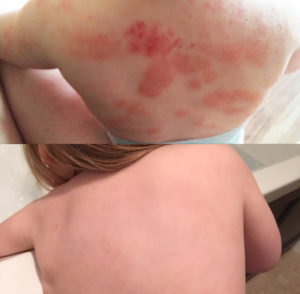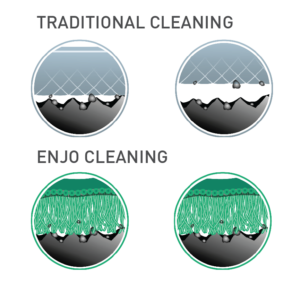
In 2014, mother Cheryl MacDonald was at her wit’s end. Her infant daughter Daisy suffered from severe, painful, itchy eczema. Upon visiting the doctor for the first time, she was prescribed a steroid cream to help clear Daisy’s skin. This was the first of many creams, medicines and treatments that would be prescribed for Daisy over the next 18 months, as Cheryl brought her daughter to weekly doctor, specialist and allergy clinic visits, trying to help with the traumatic skin disorder that kept Daisy uncomfortable and upset, and kept the family from sleeping.

Allergy tests identified changes that could improve Daisy’s overall health, but these changes brought no relief from the eczema. Cheryl was vigilant about cleaning, using the nations #1 brand of antibacterial cleanser, to avoid any triggers for Daisy at home. Both Cheryl and the doctors were researching possible treatments regularly – anything to reduce the inflamed, torturous skin outbreaks that plagued little Daisy.
Just two weeks after Daisy received her last prescription, yet another cream, Cheryl’s friend suggested she look at how she was cleaning, and suggested she try cleaning without harsh chemicals. It was at that moment, Cheryl says, “that I realized I was the problem.” She eliminated cleaning chemicals and almost all personal care products from her home, and within one week, Daisy’s skin recovered.
The hospital and doctors were astounded. Daisy’s medical chart now reads, cured by a chemical-free home. And years later, Daisy’s skin remains healthy and free from any redness or inflammation. Her younger sister, Nina, suffers from no allergies (despite the high likelihood quoted by doctors), and has never suffered from skin irritation – not even diaper rash.
Every year, children suffer from illness related to the chemicals they come in contact with – whether it is accidentally swallowed, placed on their skin, or absorbed from the air and the surfaces they encounter. Acute illnesses like eczema, allergies and asthma, as well as long-term illnesses such as cancer, reproductive health concerns and psychological issues can all be attributed to the presence of toxic chemicals in the home, leaving our families and pets at risk – children most of all.
Is this a risk that you share in your home? In generations past, chemicals in the home did not receive a lot of blame for our children’s illnesses. But continued research, and stories like Daisy’s, lead us to today, where we must think, what must we do to protect our children and their health?
HOUSEHOLD CHEMICALS
Today, the average home contains more chemicals than could be counted in the typical chemistry lab at the turn of the 20th Century.(1) When you look around your home, particularly under your sinks and in cupboards, what kind of chemicals can you find?
- Window and floor cleaners, bathroom cleansers, kitchen cleansers?
- Soaps, hair dyes, shampoos and conditioners?
- Creams, lotions, mouthwashes and toothpastes, other personal care products?
Every year, five children under the age of 14 die in Canada from poisoning, and another 1280 are hospitalized from serious injuries.(2) Over 55% of calls to Poison Control Centres for poison exposure (ingested, inhaled or skin-contact) involve children and teens under the age of 19, with 55% occurring in the home.(3)
If you don’t know the harmful effects of the cleaning and personal care products in your home, be sure to check the labels and the warning symbols. Even the most popular and trusted brands show warnings for ingestion and exposure. And from Poison Control statistics, it’s clear that no matter how we store our products, children may still gain access to them, and the possibility for illness or violent reaction, even death, is a chance we do not want to take.
What if there was a better way? Though some cleansers are now made with more natural ingredients, what if you could remove the risk altogether? What if a clean home did not mean a chemical experiment with your family?
LONG TERM HEALTH HAZARDS OF HOUSEHOLD PRODUCTS
Did you know that most chemical-induced illnesses happen slowly, over a long period of time? Daily exposure to toxins in the air and toxic chemicals that come into contact with the skin wreak havoc on our bodies and organs, little by little. Household cleaning chemicals and personal care products are among the most toxic substances that we encounter daily. The Toronto Indoor Air Commission conducted a 15-year study about the health of households, and it showed that women who worked at home had a 54% higher death rate from cancer than women who worked outside the home. This study showed that the increased death rate in the women was due to daily exposure to hazardous chemicals, mainly found in everyday household products. (4)
Our children are also exposed to these household contaminants. But sadly, children have less ability to handle the burden of these toxins on their body. As they grow, their toxin-fighting defenses and organs are still in development, and they take on more toxins pound-for-pound compared with adults. (5) And their resulting illnesses, short-term and long-term, are no less startling – cancer, developmental delays, reproductive health issues, skin diseases, allergies and asthma.
Why take the risk with your own health and your children’s? There are better ways.
TOXIC INGREDIENTS IN PERSONAL CARE PRODUCTS
Personal care products are ones that are created to clean, condition or beautify ourselves – from cleansers, to creams and conditioners, to oral care products and cosmetics. Often we do not consider their ingredients and assume they are safe. However, many of these products also carry warnings on their labels.
In a survey done by the David Suzuki Foundation, Canadians were asked to submit the ingredient lists of their personal care products and it was found that 80% of the products included at least one toxic chemical in it. Of these toxic chemicals, a specific “Dirty Dozen” caused problems such as tumours, cancer, organ function impact, hormone disruption and toxicity in the brain. (6)
Why not eliminate the risk by cutting back on the many personal care products in your home?
INDOOR AIR POLLUTION
With Canadians now spending 90% of their lives indoors (7), it is frightening to realize that indoor air quality can be 2 to 5 times worse than outside air.(8) This is exacerbated by the fact that Canadians close their homes tightly during the colder seasons for energy conservation.
There are many ways in which indoor air quality is impacted; cooking, mould presence, moisture vapors from showering and bathing, home improvements and new fixture/furniture offgassing, fireplaces and smoking. However, toxic cleaning chemicals, laundry agents and personal care products can have a significant impact on the our home’s air.
In addition to sprays and powders entering the air, these chemicals contain VOCs, or Volatile Organic Compounds. These are carbon-based compounds that turn into vapour at room temperature, and they can have significant health effects; eye, skin, throat and nose irritation, as well as exacerbation of asthma and allergies. (9)
Children’s are less able to handle VOCs than adults, given their immature organs and defenses. Their respiration rates can be up to 2 times that of an adult, and they tend to be more physically active, which may increase this rate. In addition, children are closer to the floor, where heavier gases may settle. (10)
Fortunately, parents can protect their children from inhaling toxic VOCs, and can improve the overall quality of their air. They can simply change the way they clean and the way they approach personal care.
A MESSAGE TO CONCERNED PARENTS
This information is brought to you as a guide to help you learn more about the dangers of toxic chemicals in the home, and to encourage you to seek better alternatives to help our children thrive as they live and grow.
We know there is a better way to approach our home health, and a way to reduce exposure for ourselves and our children. If we can help you to learn and make positive changes in your home, please contact your ENJOpreneur.
HOW DOES ENJO WORK?
ENJO believes that cleaning has nothing to do with chemistry.
Our system consists of microscopic fibres that reach into the tiniest crevices that are present on all surfaces.
The fibres attract and hold the dirt, dust, grease and even trapped chemical residue.
By using ENJO and water, your home is safer and cleaned pore deep.

Studies show that ENJO removes dirt, dust and grime with just fibres and water more effectively than chemical based products.
ENJO BENEFITS
![]()
Sources:
- Dadd, Home Safe Home
- Child Health and Safety Association, Potentially Dangerous Household Products
- OPC, 2010 Annual Report
- Toronto Indoor Air Commission, Exposure of Homemakers to Toxic Contaminants
- Environmental Working Group: Body Burden: Pollution in Newborns
- David Suzuki Foundation: The Dirty Dozen Cosmetic Chemicals to Avoid
- Health Canada
- Environmental Working Group: Healthy Home Guide
- Health Canada
- World Health Organization: Children Are Not Little Adults
